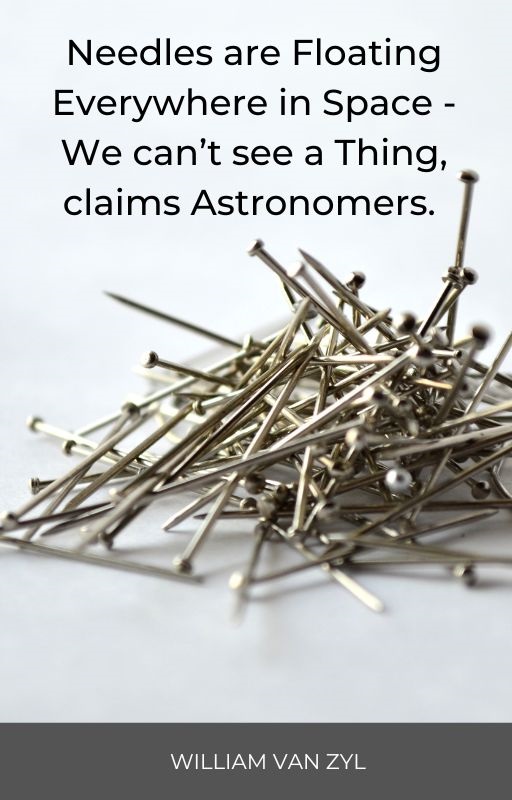
By William Van Zyl.
Published January 11, 2023.

480,000,000 tiny copper needles were released in space. Are you serious? Yes, its true.
‘I can’t see a thing. These needles are blocking my view. There are probably millions of them,’ said the astronomer.
The two men are peering into the night sky. The night is studded with small bright dots. A dense cloud – beautiful clusters – adorn the heavens. It is as if someone had strewn stardust in a vast wave action across the night sky.
A large black reflector telescope is mounted on a tripod on a hill. It is 1963. The dome of the small observatory is open.
‘Tonight is the perfect time to study stars and planets,’ said the astronomer John Blakely.
‘I cannot believe that someone didn’t stop the US government. Look at all the needles! How will astronomers study the night sky with their telescopes?’
—————————————0—————————————
It is the year 1962. Someone had released 480,000,000 tiny copper needles into space. They are floating at an altitude of between 3,500 and 3,800 kilometres (2,200–2,400 mi) at 96 and 87 degrees inclinations.
Table of Contents
What did the needles look like?
The image below shows a normal stamp on the left and a couple of the needles on the right.
Compare the size of the copper needles with an American stamp: Stamp produced by the United States Post Office Department on the left. On the right is a couple of the notorious copper needles. As you can see they were quite small. https://commons.wikimedia.org/w/index.php?curid=3698265
Please note: The introduction is partially true. The inaccurate part is that astronomers never saw the needles in the sky. Their telescopes never detected any tiny copper needles. Their view was never blocked. Nobody has ever reported seeing needles in the sky. I used the idea it to hook the reader in. But wait, before you go.
For a moment, look up into the sky. We usually look down and look around us. We focus on things like managing waste on earth, e-waste, recycling, repurposing, and more. What is floating in the sky above us? We will be shocked to find out. I was shocked to read about the needles in the sky, released around 1962.
At the time, the issue was raised in the United Nations, where then United States Ambassador to the United Nations Adlai Stevenson, defended the project. Stevenson studied the published journal articles on Project West Ford. Using what he learned on the subject and citing the articles he had read, he successfully allayed the fears of most UN ambassadors from other countries. He and the articles explained that sunlight pressure would cause the dipoles to only remain in orbit for a short period of approximately three years. The international protest ultimately resulted in a consultation provision included in the 1967 Outer Space Treaty.
What does the Outer Space Treaty include?
To protect everyone on Earth, the 1967 Outer Space Treaty bans the stationing of weapons of mass destruction (WMD) in outer space, prohibits military activities on celestial bodies, and details legally binding rules governing the peaceful exploration and use of space.
Good News, the needles are probably gone!
Thank goodness for the scenario that sunlight pressure would eventually – after about 3 years – destroy the dipoles (tiny needles), and they would eventually fall out of space. We all hope they are dust somewhere on earth by now.
—————————————–0——————————————
More about Project West Ford – Project Needles.
Project West Ford (also known as Westford Needles and Project Needles) was a test carried out by Massachusetts Institute of Technology’s Lincoln Laboratory on behalf of the United States military in 1961 and 1963 to create an artificial ionosphere above the Earth. This was done to solve a significant weakness identified in military communications.
To mitigate the potential threat, Walter E. Morrow started Project Needles at the MIT Lincoln Laboratory in 1958. The goal of the project was to place a ring of 480,000,000 copper dipole antennas in orbit to facilitate global radio communication. The dipoles collectively provided passive support to Project Westford’s parabolic dish (located at the Haystack Observatory in the town of Westford) to communicate with distant sites.
The needles used in the experiment were 1.78 centimeters (0.70 in) long and 25.4 micrometers (1.00 thou) [1961] or 17.8 micrometers (0.70 thou) [1963] in diameter. The length was chosen because it was half the wavelength of the 8 GHz signal used in the study. The needles were placed in medium Earth orbit at an altitude of between 3,500 and 3,800 kilometers (2,200–2,400 mi) at inclinations of 96 and 87 degrees.
Did you know – over and above space junk – there is more stuff floating in space?
Look at this table. Note the heading reads Artificial Radiation Belts. You will also see these belts were created by the US and the USSR (Russia) between 1958 and 1962.
List of Artificial Radiation Belts. Source: Wikipedia.
But, what are they? Firstly, let’s look at the Earth’s Magnetosphere.
A diagram of the Earth’s Magnetosphere: Protecting Our Planet From Harmful Space Radiation. Unlike Mercury, Venus, and Mars, Earth is surrounded by an immense magnetic field called the magnetosphere. Generated by powerful, dynamic forces at the center of our world, our magnetosphere shields us from erosion of our atmosphere by the solar wind (charged particles our Sun continually spews at us), erosion and particle radiation from coronal mass ejections (massive clouds of energetic and magnetized solar plasma and radiation), and cosmic rays from deep space. Our magnetosphere plays the role of gatekeeper, repelling this unwanted energy that’s harmful to life on Earth, trapping most of it a safe distance from Earth’s surface in twin doughnut-shaped zones called the Van Allen Belts. Credit: https://scitechdaily.com/earths-magnetosphere-protecting-our-planet-from-harmful-space-radiation/
You have guessed it – Nuclear explosions in space, above Earth, have created artificial Radiation Belts.
See the diagram below. It shows how a charged particle moves along one of the lines (Van Allen’s Belt). It means these charged nuclear particles move along these paths continuously.
Credit: http://www.pas.rochester.edu/~blackman/ast104/emagnetic.html
How did the particles get into the Van Allen’s Belt?
On July 9, 1962, at 0900 UT (Universal Time) a nuclear device of 1.4-megatons yield was detonated at 400 km above Johnston Island in the Pacific Ocean. Since the explosion took place in the trapping region of the magnetosphere, an artificial radiation belt of considerable intensity was produced.
Up until 1963, both the U.S. and Soviet governments conducted over 500 atmospheric nuclear weapons tests. They blew up these weapons anywhere from 16 miles above Earth to 250, well into space. The resulting fallout is estimated to have raised levels of thyroid cancer across the country, and could one day even serve as a marker for the Anthropocene—the age of humans. But the effects of these tests spread far beyond the surface of the Earth. A nuclear explosion creates a storm of charged particles similar to those emitted by the sun, with the added benefit (to scientists) of being created right near us. Researchers recently discovered that the particles from nuclear tests were lofted into belts circling the Earth, causing geomagnetic storms and even damaging a few satellites. Led by a scientist from the University of Michigan, the researchers say that the plasma created in the explosions interacted with the planet’s magnetic field and created an artificial version of the Van Allen belts that encircle the Earth. These belts are formed when particles emitted by the sun get caught up in our magnetic pull and form eddies (a current of water or air running contrary to the main current) around the Earth.
During the Cold War (around 1962), the US government launched a 1.4 megaton bomb into space. Starfish Prime, as the test was called, was the highest-altitude nuclear test in history. But what would happen if we tried the same experiment with a 50 megaton bomb, like the record-setting Tsar Bomba? Link: https://youtu.be/Jec6ZKuYgxU
What can we do about sky and space polution?
Next time you do your recycling, don’t forget to look up. We are also responsible for a sustainable sky and the space around our Earth. How can we assist to sustain our natural skies and keep our space pristine? We have to be switched on – leaders are readers. Realise what is going in our skies and in space. Tests, and experiments will affect us on Earth. Speak up.
Copyright © 2023 (William Van Zyl)
Needles are Floating Everywhere in Space – We can’t see a Thing, claims Astronomers.
All rights reserved. This eBook/article or any portion
thereof may not be reproduced or used in any manner
without the publisher’s express written permission, except for the use of brief quotations in a book review.
Published by Five House Publishing (New Zealand)
First Publishing,January, 2023
More eBooks and articles are available at https://fivehousepublishing.com/
More about the author at http://williamvanzyl.com/
Podcasts:

https://feed.podbean.com/williamvzyl/feed.xml
https://williamvzyl.podbean.com/